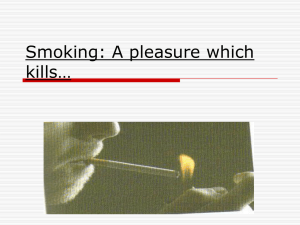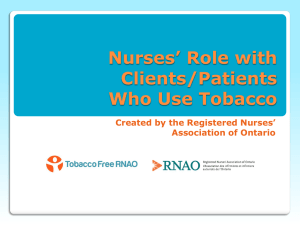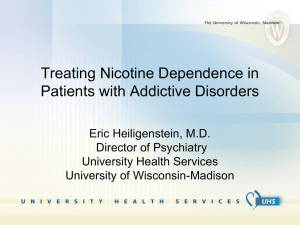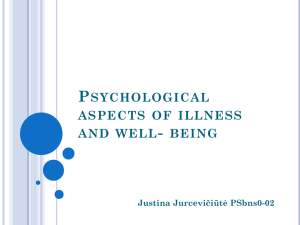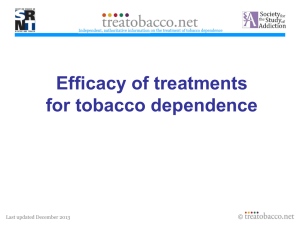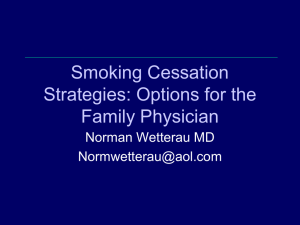n - Vilans
advertisement
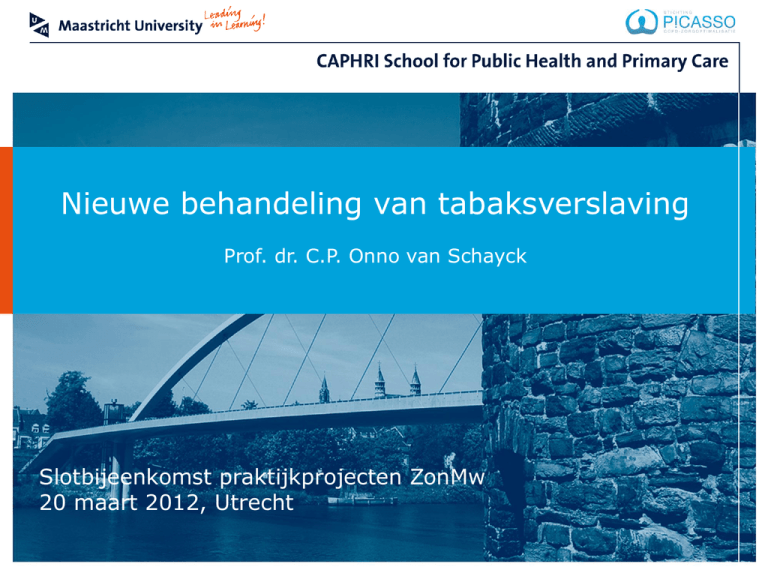
Nieuwe behandeling van tabaksverslaving Prof. dr. C.P. Onno van Schayck Slotbijeenkomst praktijkprojecten ZonMw 20 maart 2012, Utrecht Which smoking cessation strategies are effective? Simple supportive organisational infrastructure – identifying and recording all patients’ smoking status, placing smoking cessation literature and posters in waiting areas, promoting quit support services such as telephone counselling. Brief advice to quit given by a primary care doctor. Telephone smoking cessation counselling services (‘quit lines’). Pharmacotherapy for nicotine dependence. Face-to-face individual counselling by a healthcare worker trained in behavioural change and not involved in the person’s routine clinical care. Intensive intervention: in addition to all of the above, offer more intensive exploration of person’s motivation, attitudes and confidence, make a quit plan. Moderate intervention: assess barriers to quitting (quitting history, high-risk situations), briefly explore motivation, ambivalence, barriers and confidence, advise on overcoming dependence, discuss solutions, prescribe pharmacotherapy, offer support and referral to quit line, arrange follow-up; Brief intervention: discuss smoking status, assess motivation to quit and nicotine dependence, give encouragement to quit, offer advice, information and selfhelp materials, make a separate appointment to discuss smoking cessation, refer to quit line; No-smoking practice: identify and record patients’ smoking status, place smoking cessation literature and posters in waiting areas, promote quit support services; SMOKING: A GLOBAL PHENOMENON 1.25 billion smokers worldwide1 Men Women Sweden Iceland 17% 25% 18% 20%France Russian Federation Canada 30% Germany Belarus 60% 22% 37% 21% 53% 16% 17% Portugal 28% 7% US 33% Spain Italy China 24% 10% 39% 33% Egypt Iran 67% 17% 19% India 45% 22% 25% 2% 47% Mexico 12% 2% Philippines 17% 13% Kenya 41% Brazil 5% 21% 8% 22% 1% Australia 14% South Africa 19% 23% 16% Chile 8% 48% 37% Mackay J, Eriksen M. The Tobacco Atlas. Second Ed. American Cancer Society, 2006 Quitting at age 45–54 years may increase life expactancy Results From a Study of Male Physician Smokers in the United Kingdom 100 Non-smokers Stopped Age 45–54 years 80 Cigarette Smokers 70 60 50 Survival At Each Age Point (%) 90 50 40 30 20 10 0 40 Doll R et al. BMJ 2004;328:1519–27 50 60 70 80 Age (Years) 90 100 Quitting earlier (35–44 years) may have a greater impact on life expectancy Results From a Study of Male Physician Smokers in the United Kingdom 100 Non-smokers Stopped Age 35–44 years 80 Cigarette Smokers 70 60 50 Survival At Each Age Point (%) 90 50 40 30 20 10 0 40 • 50 Quitting sooner appears most beneficial 60 70 80 Age (Years) 90 100 MODEL OF DEATHS PREVENTED OR POSTPONED THROUGH RISK-FACTOR REDUCTION Quitting Smoking Unal B et al. BMJ. 2005;331:1–6. Cholesterol Reduction Blood Pressure Reduction HOW MANY PHYSICIANS ENGAGE IN SMOKING CESSATION ADVICE ACROSS EUROPE? 28% (Belgium) to 63% (UK) of GPs 36% of health professionals Stead M et al. Br J Gen Pract 2009;59:682–90 • Report asking patients about smoking status • Report always advising patients to quit smoking (study across 12 European countries) WHAT ARE THE BARRIERS TO EFFECTIVE ENGAGEMENT BY GPs? Common negative beliefs among GPs towards discussing smoking cessation with patients: – ‘Too time-consuming’ (42%) – ‘Ineffective’ (38%) – Lack confidence in ability to discuss smoking cessation (22%) – ‘Unpleasant’ (18%) – Lacked knowledge (16%) – Outside their professional duty (5%) – Discussions were inappropriate (5%) Vogt F et al. Addiction 2005;100:1423–31 WHAT ARE THE BARRIERS TO EFFECTIVE ENGAGEMENT BY GPs? Common negative beliefs among GPs towards discussing smoking cessation with patients: – ‘Too time-consuming’ (42%) – ‘Ineffective’ (38%) – Lack confidence in ability to discuss smoking cessation (22%) – ‘Unpleasant’ (18%) – Lacked knowledge (16%) – Outside their professional duty (5%) – Discussions were inappropriate (5%) Vogt F et al. Addiction 2005;100:1423–31 EVEN BRIEF ADVICE CAN INCREASE LIKELIHOOD OF QUITTING SUCCESS N Trials N Participants Pooled OR* (95% CI) Physician advice1 Brief vs no advice (usual care) Intensive vs minimal advice 17 15 13,724 9775 1.66 (1.42–1.94) 1.37 (1.20–1.56) Individual counselling2 vs minimal behaviour intervention 17 6384 1.56 (1.32–1.84) Group counselling3 vs self-help vs no intervention 16 7 4395 815 2.04 (1.60–2.60) 2.17 (1.37–3.45) 8 18,468 1.41 (1.27–1.57) 11 13,733 1.24 (1.07–1.45) Comparison Proactive telephone counselling4 vs less intensive interventions Self-help5 vs no intervention *Abstinence assessed at least 6-months following intervention 1. Lancaster T, Stead LF. Cochrane Database Syst Rev 2008;(2):CD000165 2. Lancaster T, Stead LF. Cochrane Database Syst Rev 2005;(2):CD001292 3. Stead LF, Lancaster T. Cochrane Database Syst Rev 2005;(2): CD001007 4. Stead LF et al. Cochrane Database Syst Rev 2006;(3):CD002850 5. Lancaster T, Stead LF. Cochrane Database Syst Rev 2005;(3):CD001118 EVEN BRIEF ADVICE CAN INCREASE LIKELIHOOD OF QUITTING SUCCESS N Trials N Participants Pooled OR* (95% CI) Physician advice1 Brief vs no advice (usual care) Intensive vs minimal advice 17 15 13,724 9775 1.66 (1.42–1.94) 1.37 (1.20–1.56) Individual counselling2 vs minimal behaviour intervention 17 6384 1.56 (1.32–1.84) Group counselling3 vs self-help vs no intervention 16 7 4395 815 2.04 (1.60–2.60) 2.17 (1.37–3.45) 8 18,468 1.41 (1.27–1.57) 11 13,733 1.24 (1.07–1.45) Comparison Proactive telephone counselling4 vs less intensive interventions Self-help5 vs no intervention *Abstinence assessed at least 6-months following intervention 1. Lancaster T, Stead LF. Cochrane Database Syst Rev 2008;(2):CD000165 2. Lancaster T, Stead LF. Cochrane Database Syst Rev 2005;(2):CD001292 3. Stead LF, Lancaster T. Cochrane Database Syst Rev 2005;(2): CD001007 4. Stead LF et al. Cochrane Database Syst Rev 2006;(3):CD002850 5. Lancaster T, Stead LF. Cochrane Database Syst Rev 2005;(3):CD001118 • Only 3 -5% manage to quit on willpower alone and to stay abstinent after 6 – 12 months¹ • Patients with nicotine addiction need approximately 5–7 quit attempts, before they manage to finally quit smoking² • With current therapies only modest efficacy • Abstinence rate maximum 20-25% at 1 year 1. Hughes JR, et al. Shape of the relapse curve and long-term abstinence among untreated smokers. Addiction 2004; 99(1): 29-38 2. Hughes JR. New treatments for smoking cessation. CA Cancer J Clin 2000; 50(3): 143-151 Indication pharmacotherapy – patient smokes more than ten cigarettes per day – additional support • Counselling • Nicotine replacement therapies – nicotine patch – chewing gum – sublingual tablets • Antidepressants – Bupropion – Nortriptyline • Partial nicotine agonist – Varenicline • NicVAX® (Nicotine conjugate vaccine) Cochrane review NRT All types NRT higher abstinence rate (p<0.05) • all types vs. placebo 111 RCTs, N=40.000 Stead, Cochrane Dat Sys Rev (2008) RR=1.58 17% vs. 10% Cochrane review Antidepressants • bupropion vs. placebo 31 RCTs, N=10.000 19% • nortriptyline vs. placebo 4 RCTs, N=1.000 20% Hughes, Cochrane Dat Sys Rev (2007) OR=1.94 vs. 10% OR=2.34 vs. 10% 100 Response Rate (%) OR=2.66 40 (95% CI 1.72, 4.11) p<0.0001 OR=1.72 (95% CI 1.16, 2.55) p<0.0062 20 23.0 15.0 0 N=343 Varenicline N=340 Bupropion 10.3 N=340 Placebo Jorenby, Jama (2006) Nicotine addiction CNS effect • Nicotine binds to the nicotine acetylcholine (nACh) receptors in the central nervous system; the Ventral Tegmental Area (VTA) • After binding to the 42 nicotinic receptor in the VTA, dopamine is released in the Nucleus Accumbens (nAcc) • This dopamine release is causing the feeling of reward 2 2 4 2 4 42 Nicotine Receptor 1. Picciotto MR, Zoli M, Changeux J. Nicotine Tob Res. 1999; Suppl 2:S121-125. 2. Dani JA, Harris RA. Nature Neuroscience 2005; 8:1465-1470. Nicotine vaccination … The magic bullet? Relevance The influential German news site Spiegel Online mentions NicVAX in a recent article as one of the 15 revolutionary inventions that could change our life: www.spiegel.de/wissenschaft/technik/0,1518,694845-6,00.html Nicotine addiction NicVAX – the vaccine Overcome the addiction Working mechanism • Antibodies to nicotine • Prevents nicotine entering the brain • No satisfaction as a result NicVAX studies thusfar in the Netherlands • 4503 Phase I/II, Maastricht 2003 – 30 subjects (24 NicVAX, 6 Placebo) • Double-Blind, Placebo-Controlled, safety and immunogenicity • 100 ug NicVAX, 4 vaccinations, Weeks 0, 2, 4, 26 • 4505 Phase II Dose ranging, Maastricht 2004 – 50 subjects (50 NicVAX) • Open label, Single center, dose escalation study • 100-400 ug NicVAX, 5 vaccinations, Weeks 0, 3, 6, 9, 26 • 4508 Phase II/III, Maastricht 2008 – 600 subjects (300 NicVAX, 300 Placebo) • Double-Blind, Placebo-Controlled, safety and immunogenicity • RCT NicVAX placebo-controlled In the Netherlands 27% of the general population still smokes. The good news is that adolescents do not seem to start smoking as much as before. Smoking cessation in adolescents Study among 20 000 – 27 500 adolescents from 1996 - 2005. Reduction of smoking in Dutch adolescents over the past decade and its health gains: a repeated crosssectional study Cindy M. Gielkens-Sijstermans, Monique A. Mommers, Rudolf T. Hoogenveen, Talitha L. Feenstra, Jacqueline de Vreede, Fons M. Bovens, Onno C. van Schayck Eur J Public Health 2009; doi:10.1093/eurpub/ckp115 Methods • In 1996, 2001 and 2005, a survey was conducted in the south-eastern region of the Netherlands. • All students in second and fourth year of secondary education (1996: n=20 000; 2001: n=27 500; 2005: n=24 000) completed a questionnaire. Results (1) Results (2) Results (3) • Time trends were not influenced by gender or educational level. • Model projections show that if these students not take up smoking later in life, 11 500 new cases of COPD, 3400 new cases of lung cancer and 1800 new cases of myocardial infarction could be prevented for the Dutch 13-year-olds. So the good news is that in the past decade smoking prevalence among adolescents has declined by almost 50%, potentially resulting in a considerable reduction in new cases of COPD, lung cancer or cardiovascular diseases.



